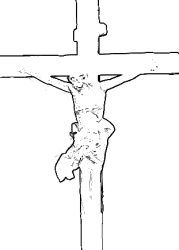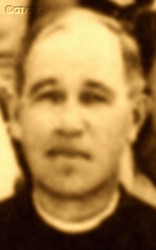Roman Catholic
St Sigismund parish
05-507 Słomczyn
85 Wiślana Str.
Konstancin deanery
Warsaw archdiocese, Poland
full list:
displayClick to display full list

searchClick to search full list by categories
wyświetlKliknij by wyświetlić pełną listę po polsku

szukajKliknij by przeszukać listę wg kategorii po polsku

Martyrology of the clergy — Poland
XX century (1914 – 1989)
personal data
surname
ROJSZA
forename(s)
Albin

function
diocesan priest
creed
Latin (Roman Catholic) Church RCmore on
en.wikipedia.org
[access: 2014.09.21]
diocese / province
Pinsk diocesemore on
en.wikipedia.org
[access: 2013.05.19]
Minsk diocesemore on
en.wikipedia.org
[access: 2013.05.19]
Mogilev archdiocesemore on
en.wikipedia.org
[access: 2013.06.23]
honorary titles
Gold „Cross of Merit”more on
en.wikipedia.org
[access: 2019.04.16]
(19.08.1937)
date and place
of death
19.07.1942

Kosava Poleskayatoday: Kosava, Ivatsevichy dist., Brest reg., Belarus
more on
en.wikipedia.org
[access: 2021.12.19]
details of death
After German and Russian invasion of Poland in 09.1939 and start of the World War II, after German attack of their erstwhile ally Russians, arrested by the Germans together with his organist and a dozen or so other Polish settlers in 07.1942.
After a few days kicked out in the morning from his detention cell and marched towards a nearby Yelyavasty forest.
There murdered by the Germans.
cause of death
mass murder
perpetrators
Germans
sites and events
«Polenaktion» 1942Click to display the description, Ribbentrop‐MolotovClick to display the description, Pius XI's encyclicalsClick to display the description
date and place
of birth
1882

presbyter (holy orders)
ordination
08.12.1906

positions held
1933 – 1942
dean — Kosava Poleskayatoday: Kosava, Ivatsevichy dist., Brest reg., Belarus
more on
en.wikipedia.org
[access: 2021.12.19] RC deanery
1933 – 1942
parish priest — Kosava Poleskayatoday: Kosava, Ivatsevichy dist., Brest reg., Belarus
more on
en.wikipedia.org
[access: 2021.12.19] ⋄ The Holy Trinity and the Holy Cross RC parish ⋄ Kosava Poleskayatoday: Kosava, Ivatsevichy dist., Brest reg., Belarus
more on
en.wikipedia.org
[access: 2021.12.19] RC deanery
1928 – 1933
parish priest — Ruzhanytoday: Ruzhany ssov., Pruzhany dist., Brest reg., Belarus
more on
en.wikipedia.org
[access: 2020.12.11] ⋄ Holy Trinity RC parish ⋄ Kosava Poleskayatoday: Kosava, Ivatsevichy dist., Brest reg., Belarus
more on
en.wikipedia.org
[access: 2021.12.19] RC deanery
till 1928
dean — Stalavichytoday: Stalavichy ssov., Baranavichy dist., Brest reg., Belarus
more on
be.wikipedia.org
[access: 2022.12.25] RC deanery
1921 – 1928
parish priest — Stalavichytoday: Stalavichy ssov., Baranavichy dist., Brest reg., Belarus
more on
be.wikipedia.org
[access: 2022.12.25] ⋄ Heart of Jesus RC parish ⋄ Stalavichytoday: Stalavichy ssov., Baranavichy dist., Brest reg., Belarus
more on
be.wikipedia.org
[access: 2022.12.25] RC deanery
1914 – 1919
parish priest — Kroshintoday: Kroshin ssov., Baranavichy dist., Brest reg., Belarus
more on
be.wikipedia.org
[access: 2023.01.18] ⋄ Corpus Christi RC parish ⋄ Stalavichytoday: Stalavichy ssov., Baranavichy dist., Brest reg., Belarus
more on
be.wikipedia.org
[access: 2022.12.25] RC deanery — following the destruction of the parish church in 1914, served from Juszkiewicze
1909 – 1914
parish priest — Kameshevtsytoday: Berezki ssov., Dokshytsy dist., Vitebsk reg., Belarus
more on
be.wikipedia.org
[access: 2023.01.18] ⋄ Transfiguration of the Lord RC parish ⋄ Barysawtoday: Barysaw dist., Minsk reg., Belarus
more on
en.wikipedia.org
[access: 2022.09.11] RC deanery
priest — Babruysktoday: Babruysk dist., Mogilev reg., Belarus
more on
en.wikipedia.org
[access: 2020.12.11] ⋄ Immaculate Conception of the Blessed Virgin Mary RC parish ⋄ Babruysktoday: Babruysk dist., Mogilev reg., Belarus
more on
en.wikipedia.org
[access: 2020.12.11] RC deanery
sites and events
descriptions
«Polenaktion» 1942: In the summer of 1942 in German‐occupied Germ. Generalbezirk Weißruthenien (Eng. General Region of Belarus) — in Nowogródek region among others — Germans carried out «Polenaktion» initiative: the name introduced in a special resolution drafted by Reichssicherheitshauptamt RSHA (Eng. Reich Main Security Office). The action included sacking of all Poles from civilian regional apparatus and police and replacing them with Belarusians. Thousands of Poles were also forcibly deported to Germany as slave labourers. On 26‐30.06.1942 in all counties of the region more than 1,000 representatives of Polish intelligentsia were arrested and subsequently murdered. In Lida region 16 Polish priests were arrested among others. 5 Polish parish priests from Hlybokaye and Pastavy deanery were murdered as well. At the same time Germans set up KL Koldichevo concentration camp n. Baranavichy. The implementation of this genocide project was entrusted to Belarusian collaborationist formations, political, administrative — responsible for preparation of proscription lists — and police, i.e. niem. Weißruthenische Hilfspolizei (Eng. Belarusian Auxiliary Police), supported by Ukrainian, Lithuanian, Latvian and Russian (RONA) collaborators. The action was coordinated with the liquidation of the Jewish ghettos in the Germ. Generalbezirk Weißruthenien.
Ribbentrop‐Molotov: Genocidal Russian‐German alliance pact between Russian leader Joseph Stalin and German leader Adolf Hitler signed on 23.08.1939 in Moscow by respective foreign ministers, Mr. Vyacheslav Molotov for Russia and Joachim von Ribbentrop for Germany. The pact sanctioned and was the direct cause of joint Russian and German invasion of Poland and the outbreak of the World War II in 09.1939. In a political sense, the pact was an attempt to restore the status quo ante before 1914, with one exception, namely the „commercial” exchange of the so‐called „Kingdom of Poland”, which in 1914 was part of the Russian Empire, fore Eastern Galicia (today's western Ukraine), in 1914 belonging to the Austro‐Hungarian Empire. Galicia, including Lviv, was to be taken over by the Russians, the „Kingdom of Poland” — under the name of the General Governorate — Germany. The resultant „war was one of the greatest calamities and dramas of humanity in history, for two atheistic and anti‐Christian ideologies — national and international socialism — rejected God and His fifth Decalogue commandment: Thou shall not kill!” (Abp Stanislav Gądecki, 01.09.2019). The decisions taken — backed up by the betrayal of the formal allies of Poland, France and Germany, which on 12.09.1939, at a joint conference in Abbeville, decided not to provide aid to attacked Poland and not to take military action against Germany (a clear breach of treaty obligations with Poland) — were on 28.09.1939 slightly altered and made more precise when a treaty on „German‐Russian boundaries and friendship” was agreed by the same murderous signatories. One of its findings was establishment of spheres of influence in Central and Eastern Europe and in consequence IV partition of Poland. In one of its secret annexes agreed, that: „the Signatories will not tolerate on its respective territories any Polish propaganda that affects the territory of the other Side. On their respective territories they will suppress all such propaganda and inform each other of the measures taken to accomplish it”. The agreements resulted in a series of meeting between two genocidal organization representing both sides — German Gestapo and Russian NKVD when coordination of efforts to exterminate Polish intelligentsia and Polish leading classes (in Germany called «Intelligenzaktion», in Russia took the form of Katyń massacres) where discussed. Resulted in deaths of hundreds of thousands of Polish intelligentsia, including thousands of priests presented here, and tens of millions of ordinary people,. The results of this Russian‐German pact lasted till 1989 and are still in evidence even today. (more on: en.wikipedia.orgClick to attempt to display webpage
[access: 2015.09.30])
Pius XI's encyclicals: Facing the creation of two totalitarian systems in Europe, which seemed to compete with each other, though there were more similarities than contradictions between them, Pope Pius XI issued in 03.1937 (within 5 days) two encyclicals. In the „Mit brennender Sorge” (Eng. „With Burning Concern”) published on 14.03.1938, condemned the national socialism prevailing in Germany. The Pope wrote: „Whoever, following the old Germanic‐pre‐Christian beliefs, puts various impersonal fate in the place of a personal God, denies the wisdom of God and Providence […], whoever exalts earthly values: race or nation, or state, or state system, representatives of state power or other fundamental values of human society, […] and makes them the highest standard of all values, including religious ones, and idolizes them, this one […] is far from true faith in God and from a worldview corresponding to such faith”. On 19.03.1937, published „Divini Redemptoris” (Eng. „Divine Redeemer”), in which criticized Russian communism, dialectical materialism and the class struggle theory. The Pope wrote: „Communism deprives man of freedom, and therefore the spiritual basis of all life norms. It deprives the human person of all his dignity and any moral support with which he could resist the onslaught of blind passions […] This is the new gospel that Bolshevik and godless communism preaches as a message of salvation and redemption of humanity”… Pius XI demanded that the established human law be subjected to the natural law of God , recommended the implementation of the ideal of a Christian state and society, and called on Catholics to resist. Two years later, National Socialist Germany and Communist Russia came together and started World War II. (more on: www.vatican.vaClick to attempt to display webpage
[access: 2023.05.28], www.vatican.vaClick to attempt to display webpage
[access: 2023.05.28])
sources
personal:
www.iwieniec.euClick to attempt to display webpage
[access: 2012.12.28], www.yumpu.comClick to attempt to display webpage
[access: 2014.12.20]
bibliographical:
„Martyrology of the Polish Roman Catholic clergy under nazi occupation in 1939‐1945”, Victor Jacewicz, John Woś, vol. I‐V, Warsaw Theological Academy, 1977‐1981
„Pinsk Diocese in Poland Clergy and Church Register”, Pinsk diocese bishop, 1933‐1939, diocesan printing house
LETTER to CUSTODIAN/ADMINISTRATOR
If you have an Email client on your communicator/computer — such as Mozilla Thunderbird, Windows Mail or Microsoft Outlook, described at WikipediaPatrz:
en.wikipedia.org, among others — try the link below, please:
LETTER to CUSTODIAN/ADMINISTRATORClick and try to call your own Email client
If however you do not run such a client or the above link is not active please send an email to the Custodian/Administrator using your account — in your customary email/correspondence engine — at the following address:

giving the following as the subject:
MARTYROLOGY: ROJSZA Albin
To return to the biography press below:
 Click to return to biography
Click to return to biography








